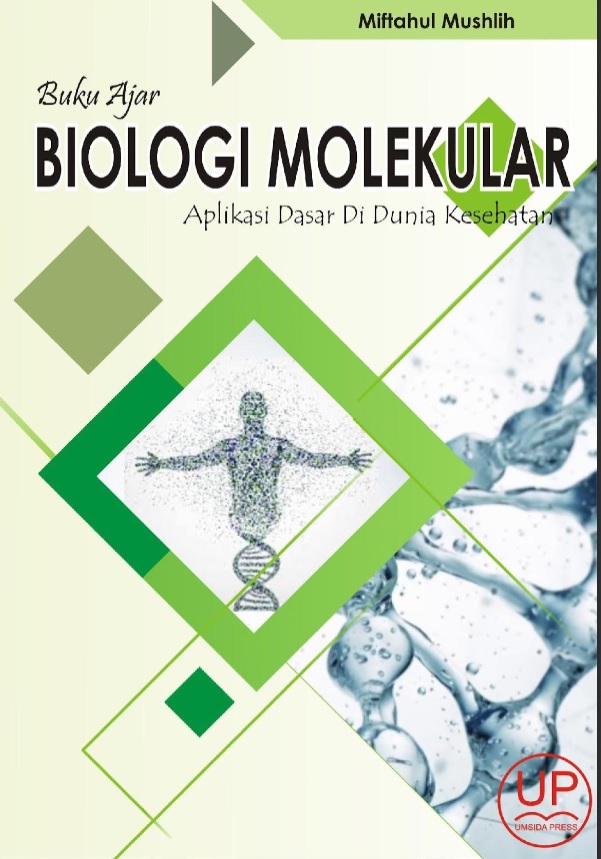Buku Ajar Mata Kuliah Biologi Molekuler “Aplikasi Dasar Di Dunia Kesehatan”
DOI:
https://doi.org/10.21070/2019/978-623-6081-07-5Keywords:
Buku Ajar, Mata Kuliah, Biologi, MolekulerAbstract
Biologi Molekuler merupakan cabang ilmu Biologi yang sekarang mulai mendapat perhatian serius guna meningkatkan kesejahteraan manusia. Biologi Molekular sendiri hampir selalu digunakan bagi cabang cabang keilmuan yang bersentuhan dengan jasad hidup baik itu tumbuhan, hewan, bakteri, jamur dan tidak lepas didalamnya adalah Manusia.Pemanfaatan bidang Biologi Molekuler di dunia kesehatan dapat dikatakan masing sangat terbatas. Namun demikian para ahli memperkirakan Kedudukan Biologi molekular di dunia kesehatan akan menjadi solusi di masa depan, hal ini berkaitan dengan deteksi penyakit, tindakan preventif, diagnosis, therapy gen, finger printing bahkan pada rekayasa genetika. Pada akhirnya penulis berharap bahwa buku ini menjadi salah satu batu loncatan bagi para praktisi khususnya di bidang Ahli Teknologi Laboratorium Medis (ATLM) baik di tingkat praktisi maupun akademisi untuk memahami biologi molekular secara lebih mendalam.Pada akhir kata, penulis ingin menyampaikan banyak terimakasih atas terselesaikannya penulisan ini kepada pihak pihak terkait, khususnya istri (Dian Delta), kolega Universitas Muhammadiyah Sidoarjo dan teman teman yang memberi saran guna menyempurnakan buku ini.
Downloads
References
Ardiana, D.W. 2009. Teknik Isolasi DNA Genom Tanaman Pepaya dan Jeruk dengan Menggunakan Modifikasi Bufer CTAB. Buletin Teknik Pertanian Vol. 14 No. 1 : 12-16.
Ausubel, F.M., Brent, R., Kongston, R.E., Moore, D.D., Saidman, J.G., Smith J.A., & Stuhl, K. 1994. Current Protocols in Molekular Biology. John Wiley and Sons, Inc. New York, pp: 193-196.
Bremer, B., Anderberg, A. A., & Mari, K. (2002). Phylogenetics of asterids based on 3 coding and 3 non-coding chloroplast DNA markers and the utility of non coding DNA at higher taxonomic levels. 24, 274–301.
Cambell N. A., Reece J. B., Urry L. A., Cain M. L., Wasserman S. A., Minorsky P. V., & Jackson R. B. 2008. Biologi, edisi 8, jilid 1. Jakarta= Erlangga.
Davis, L., Kuehl, M. & Battey, J. 1994. Basic method in Molekular Biology, 2nd edition. America::ibrary of congress Cataloging.
Elrod S. L. & Stansfield W. D. 2007. Schaum’s Outlines Teori dan soal Genetika, edisi ke empat, Jakarta= Erlangga
Erlich, H. A. 1989. PCR technology: Principle and Applications for DNA Amplification. Britain: Stockton press.
Garibyan, L. & Avashia, N. 2013 Polymerase Chain Reaction. Journal of Investigative Dermatology. vol. 133:1-4,
Hardwell (2003). The Human Genome Project : Its Implications in Clinical Medicine. 51(April), 373–380.
Hartwell, L. H., Hood, L., Goldberg, M.L., Reynolds, A.E., & Silver, L. M., (2011). Genetics: From Genes To Genomes, Fourth Edition. America: McGraw-Hill.
Holland, C. A., & Kiechle, F. L. (2005) Point-of-care molekular diagnostic systems — past , present and future. https://doi.org/10.1016/j.mib.2005.08.001
Human Genome Project : Expectations and Current Status. (2016). 2(4), 2–4. https://doi.org/10.15406/japlr.2016. 02.00029
Karp, Gerald. 2008. Cell and Molekular Biology. New York: John Willey & Sons, Inc. pp. 567-573.
Kass, D. H., & Batzer, M. A. (2001). Genome Organization /. 1–8.
Kozel, T. R., & Burnham-marusich, A. R. (2017). crossm Diseases : Past , Present , and Future, 55(8), 2313–2320.
Lefkowitz R. dan Kobilka K. B. 2012. G-Protein-Coupled receptors. Kungl. Vetenskaps Akademien
Mattick, J. S., Dziadek, M., Terrill, B., Kaplan, W., Spigelman, A. D., & Dinger, M. E. (2010). The impact of genomics on the future of medicine and1 health (Figure1), 1–12.
Nobel prize committee, 2012. Mature cell can be reprogrammed to become pluripotent.
Pardo, A. (2004). The Human Genome and Advances in Medicine : Limits and Future Prospects, 133–138.
Roses, E. W., Jeon, J., & Kim, S. (2019). Comparative Analysis of the Complete Chloroplast Genome Sequences of Three Closely Related. 6–8. https://doi.org/10.3390/genes10010023
Shafee, T., & Lowe, R. (2017). Eukaryotic and Prokaryotic Gene Structure. Ssrn, (January). https://doi.org/10.2139/ssrn.3013506
Srivastava, S., Srivastava, P. S., Srivastava, S., & Srivastava, P. S. (2013). Cell Structure and Organization. Understanding Bacteria, 61–95. https://doi.org/10.1007/978-94-017-0129-7_4
Steward K. B. 2007. The Human Genetic Code- The Human Genome Project and Beyont. (www. Genetic. Edu. Au).
Susman, M. (2006). Genes: Definition and Structure. Encyclopedia of Life Sciences, (1), 1–7. https://doi.org/10.1038/npg.els.0001494
Tan, S. C., & Yiap, B. C. (2009). DNA , RNA , and Protein Extraction : The Past and The Present. 2009. https://doi.org/10.1155 /2009/574398
Vira, H., Bhat, V., & Chavan, P. (2016). Diagnostic molekular microbiology and its applications : Current and future perspectives, 1(1), 20–31. https://doi.org/10.15761/CMID. 1000105
Willey J. M., Sherwood L. M., & Woolverton C. J. 2009. Prescott’s Principles of MICROBIOLOGY The McGraw-Hill Companies.
Yuwono, Triwibowo. 2005. Biologi Molekular. Jakarta: Erlangga.

Downloads
Published
How to Cite
Issue
Section
Categories
License
Authors retain copyright and grant the Umsida Press right of first publication with the work simultaneously licensed under a Creative Commons Attribution 4.0 International License that allows others to share the work with an acknowledgement of the work's authorship and initial publication in this platform.

